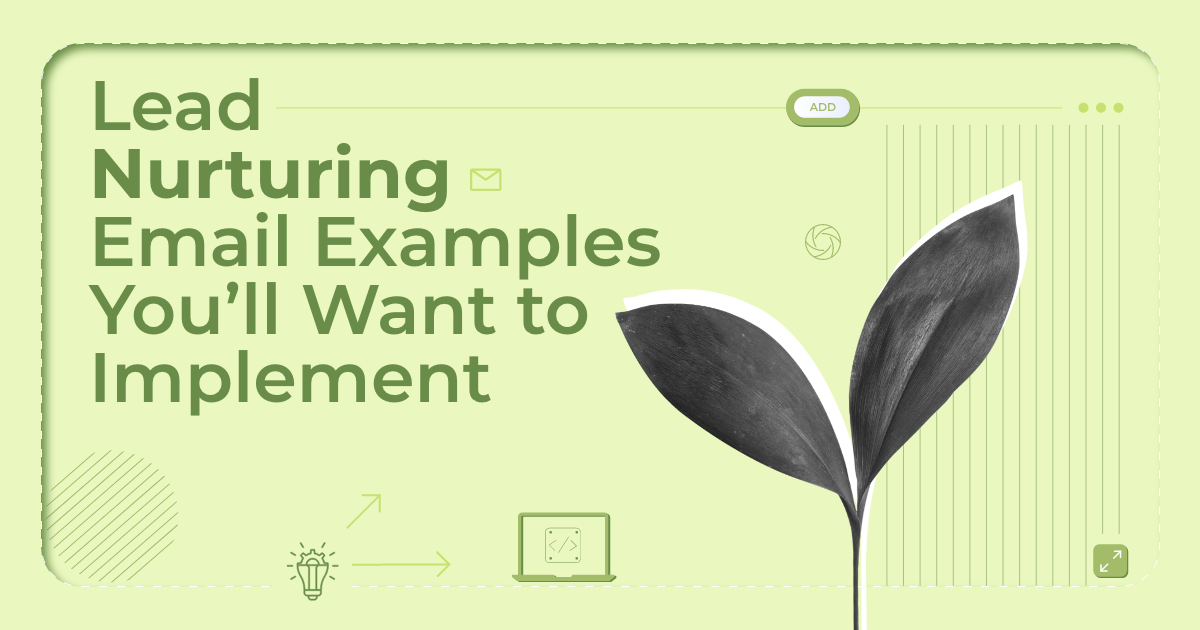
10 Product Recommendation Email Examples to Boost Your Sales
Picture this: You get an email with a brand’s catalog of new products. Then you get another email from a different brand that has shortlisted three or four products they think you’ll like based on your previous purchases. Which one will grab your attention?
Most customers love product recommendations, especially if they’re highly personalized and timely.
Wondering how to streamline this tactic without wasting valuable time and resources? Explore some top product recommendation email examples and types you’d better include in your strategy to bear fruit.
What Is a Product Recommendation Email?
A product recommendation email is a promotional campaign type providing product or service recommendations to subscribers to increase sales and customer engagement.
They usually include personalized product suggestions based on user activity, such as browsing or purchase history. However, sometimes businesses choose to send more generic recommendations in bulk, displaying their best-seller products or seasonal services.
Plus, product recommendations can either be standalone emails or part of other email marketing campaigns. For instance, you can include a complementary product section in order confirmation emails to boost sales.
What Are the Benefits of Product Recommendation Emails?
Here are the main gains of introducing product recommendation emails in your marketing strategy:
- Drive more sales: Sharing related products with customers at certain times during their journey can increase your conversion rates and average order value.
- Increase brand awareness: Through recommended products, you can show customers and prospects what your brand can offer them to get them back on your website shortly.
- Boost customer engagement: Showing customers that you care about their interests and needs will help you keep them on board for a long time.
- Save money: Email marketing is an affordable marketing solution compared to other targeted tactics such as paid ads, enabling you to earn more with less.
To reap all these benefits, you’ll need top-notch email automation software to streamline your work. For example, with Moosend, you can use website tracking, premade email templates, and dynamic blocks to ensure your subscribers will get the best possible recommendations.
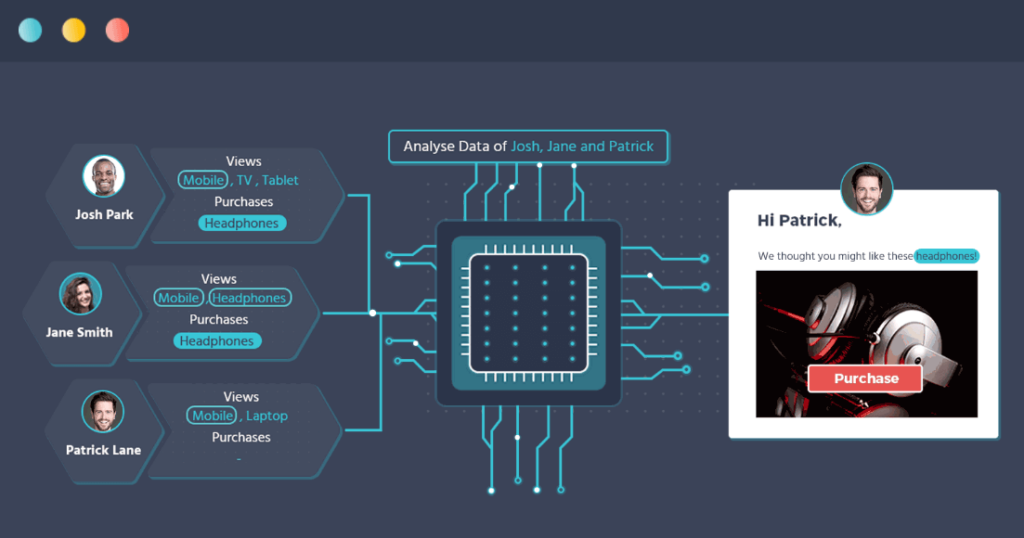
10 Top Product Recommendation Email Examples to Get Inspired
Let’s explore some top product email recommendation examples to decide which ones to use based on your industry and target audience:
1. Welcome emails
Welcome emails are triggered when someone signs up for your email list for the first time. Such emails are top performing with a remarkably high open rate that can reach up to 83.65%.
When someone decides to subscribe to your list, they’re genuinely interested in your brand, and you have their full attention. At least for a few seconds. Before it starts to span away, you can use a few best practices to stick to their memory. Two of the most prominent are providing product recommendations and a discount for their first purchase to boost conversions.
Let’s see a great welcome example by Art of Tea that combines the two strategies:
Subject line: Welcome to our CommuniTea

Why it works:
They chose to recommend their bestsellers to entice new subscribers with some of their most popular products. They added short descriptions next to each one, followed by “Shop Now” call-to-action buttons to create a sense of urgency.
Now, combined with a 10% off the first purchase and a loyalty rewards program, it’s hard to stay away from the checkout for long.
2. Abandoned cart emails
Abandoned cart and browse abandonment emails are essential for every eCommerce store aiming to drive sales through simple marketing automation tactics. After reminding your customers about the products or services they recently left in their cart, why not give them a few product suggestions, as well?
It’s up to you to decide what you’d like to share in this case. For example, you can show related products to indulge prospects who might be looking for something else in this category or highlight your new arrivals to gain more traction.
Here’s an abandoned cart email example with product recommendations by Grove Collaborative:
Subject line: Where’d you go?

Why it works:
After placing the abandoned items in a row inviting subscribers to complete their order, they added a few more items under the title “Recommended for You.” This adds a personalized angle to the message readers will find hard to skip.
3. Cross-selling/Upselling campaigns
Cross-selling and upselling are among the most popular marketing strategies aiming to boost ROI based on relevant or complementary product recommendations regarding products or services.
To nail this email strategy, you can trigger those recommendations based on personal data, such as browsing history to increase your conversion chances. Overall, these personalized emails can highly impact your ROI.
Here’s a relevant product recommendation email example by Canva, a content creation brand with a freemium pricing model, to get inspired:
Subject line: Unlock the top 3 premium Canva features 🔓

Why it works:
Canva invites existing customers or prospects to check out three premium features and claim them fast. In the head title, they mentioned that these features are “everyone’s favorite” to grab their attention and create a FOMO effect.
Then, they described the assets of each feature, and the pain points they relieve followed by powerful CTA buttons. Finally, they added a sneak peak of the pricing plans for transparency to convince even reluctant prospects to give them a go.
4. Post-purchase Emails
Post-purchase emails, such as order, payment, and shipping confirmations, usually yield high open rates as customers want to double-check specific information. This gives brands an excellent opportunity to promote specific products customers would love to have as well.
However, it’s important to add those recommendations organically in your email campaigns to avoid looking spammy to your customers.
Check out this example by Crate&Barrel:
Subject line: Order Confirmation #123456789
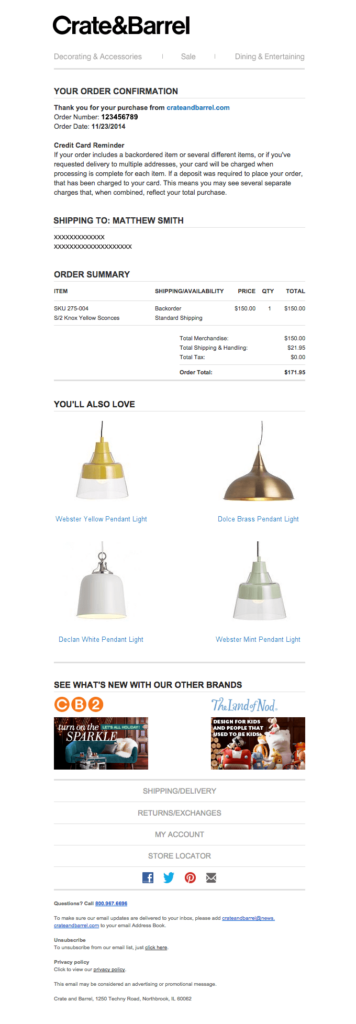
Why it works:
Below the order confirmation details and summary, they added a few product recommendations with the title “You’ll also love” to grab their full attention. Plus, they invited readers to check out what’s new in their other brands to bring traction there, too.
So, if you want to go in that direction, you can follow this example and track your subscribers’ activity to see if this recommendation strategy bears fruit.
Want to set up transactional emails with ease? Sign up for a Moosend account and reassure your customers that the actions they took are completed.
5. Back-in-stock campaigns
Informing customers and prospects that some of your top-selling products are back in stock is an excellent tactic to boost sales. You can send them in the form of bulk emails or nudge customers who’ve shown a preference to those products based on previous purchases.
Clarify what this campaign is about in the email subject line to yield higher open and click-through rates to meet your conversion goals.
Check out how AWAY attracted readers from the beginning with a descriptive subject line.
Subject line: Back in stock: The Bigger Carry-On

Why it works:
The brand informed customers that one of their best-selling products is back-in-stock to give them the opportunity to claim it fast. They added an image displaying the product in two colors and a clear CTA button to increase click-throughs.
Finally, the free returns and shipping details below can also incentivize them to buy them before their next vacation.
6. Win-back emails
Win-back emails aim at rekindling the relationship with inactive or churn subscribers and customers. Marketers create several types of emails to avoid waving goodbye for good, from offering discounts to running customer surveys.
Re-engagement emails also fall in this category as they have the same goal—winning someone’s attention and trust to complete a favored action, such as purchasing. And of course, product recommendations could not be missing from a marketer’s action list, especially when they rely on past purchases.
Here’s an excellent example by Surreal that did it in style:
Subject line: You’ve got Surreally good taste 👌

Why it works:
They kicked off with a creative subject line to grab their attention and continued with the clever copywriting. “Come back and dive into the goodness” is a great way to win them over and get them to the checkout again. They also included a customer testimonial to make it more appealing.
7. Seasonal emails
Many retailers and eCommerce business owners rely on holidays such as Christmas, Halloween, and Valentine’s to promote specific products that are popular in each season. These holiday emails, when combined with limited time offers and similar incentives can work miracles for a brand.
Moreover, these email types give brands a fantastic opportunity to become more creative with their campaigns to gain extra customer loyalty points, especially when offering personalized recommendations.
See how Nuts.com displays their Halloween products to win customers’ hearts the spooky way:
Subject line: In the Spirit of Halloween 👻

Why it works:
This amazing design includes all the seasonal elements needed to convert, from pumpkin decorations to candy worms. Plus, the brand offered a discount to make this offer more appealing and maximize sales for this season.
If seasonal product recommendations sound like a good plan, find our dedicated templates in our library to wow your audience with a few drags and drops.
8. Product launch emails
When a business launches a new product, the first people they want to share the great news with are their customers. Help them discover what you’ve got for them by sending a dedicated email campaign.
Mention the benefits of each product and the pain points it will resolve so that people can understand their value. Also, if you want to give it a boost, you can offer a limited-time discount or pre-order options for real fans.
Here’s a new product recommendation example by Nomad:
Subject line: Introducing: GLOW 2.0 🔦

Why it works:
They introduced a limited-edition product customers would love to have. They stressed that it’s important to shop for it quickly – within a few hours – after the launch to get it. To make the time limit stick even more, you can also use a countdown timer to add a sense of urgency.
9. Giveaway email
Many businesses choose to run giveaway contests via email or social media to boost brand awareness and share products with their target audience. If you want to follow this tactic to reap these benefits, choose one of your most popular products or services to make winners feel delighted with your brand.
Check out how Counter Culture Coffee did it to get inspired:
Subject line: 💚💙 GIVEAWAY ❤️💜
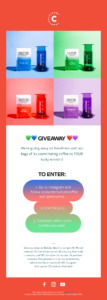
Why it works:
Through this giveaway contest, the brand portrayed one of their top products in four different colors for four lucky winners. All they had to do to enter the contest was follow two accounts on IG, like the post, and write down the color they wanted.
When sending similar emails, be specific with the guidelines and the expiration date to avoid confusing contestants.
10. Loyalty program emails
Finally, you can share exclusive deals and product recommendations with loyal customers or people who join your rewards program. This way, you show them that they’ll always get something in return when they’re active members of your community.
Plus, repeat customers are lifesaving for brands, as they keep the revenue coming. They also act as brand ambassadors.
Here’s an example by McDonalds’:
Subject line: Exclusive Deal: Cuz you deserve it 😎
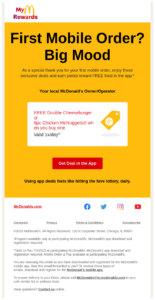
Why it works:
McDonald’s rewards their first-time mobile app users with an exclusive deal and an earning point system to receive similar benefits in the future. They recommended two popular meal options to get them started.
Finally, they added some terms and conditions in the email footer to inform users further about these deals and how to claim them.
Product Recommendation Email Best Practices
Here are some top tips to strengthen your product recommendations strategy and create emails that are hard to ignore.
Choose an effective email design
To show your product recommendations in the best way possible, you need a clear email layout that will make them stand out. For example, you can select the F- or Z-pattern and add pixel-perfect product visuals to grab your subscribers’ attention.
Most email marketing services like Moosend or Mailchimp offer responsive and customizable email templates to create beautiful emails in simple steps while saving your budget. For instance, this template can do the trick:
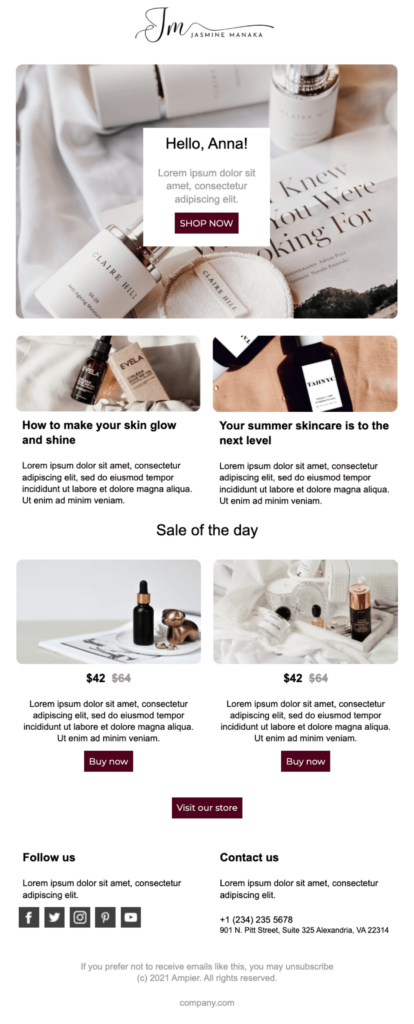
Write an attractive subject line
The subject line is the first impression you’ll make on subscribers when your email lands in their inbox, and long story short, you need to nail it.
Boost your open rates by writing an attractive subject line that reflects the purpose of the email so that people with relevant interests and intents open them. Plus, make it up to 50 characters to be responsive for different devices.
Here are few product recommendation email subject lines from other brands if you need some inspiration:
- Did you like [previous product]? Try these!
- More goodies we think you’ll adore.
- New arrivals selling fast 🔥
- Tired of leaving empty-handed, [NAME]?
- Say hi to our best-seller
Optimize your copy
The truth is that probably no-one asked you for a product recommendation at the first place, so you must act elegantly. Avoid sounding spammy and flow with a more personal writing tone, showing customers that you did some work on their behalf because you care.
Therefore, when adding product recommendations, adopt a personalized angle to your copy to show them why you present them with these choices. Are they based on earlier purchases or are they bestsellers they would probably love?
Plus, emphasize the benefits of each product and add social proof, such as testimonials or customer reviews to make them more appealing.
Leverage personalization
Regarding personalization, most email marketing software offers users relevant features to make it happen. For example, automation workflows and email segmentation help you deliver more targeted and timely content your subscribers will love.
Moreover, they offer eCommerce-oriented features to help you streamline your email marketing efforts without wasting valuable energy. Moosend has dedicated product recommendation and eCommerce AI features to help users deliver personalized email campaigns based on data-driven solutions.
For example, Audience Discovery will analyze customer behavior, build smart segments, and suggest relevant content to each group. Plus, you can unveil a user’s intent and use a tagging system to deliver more fitting campaigns.
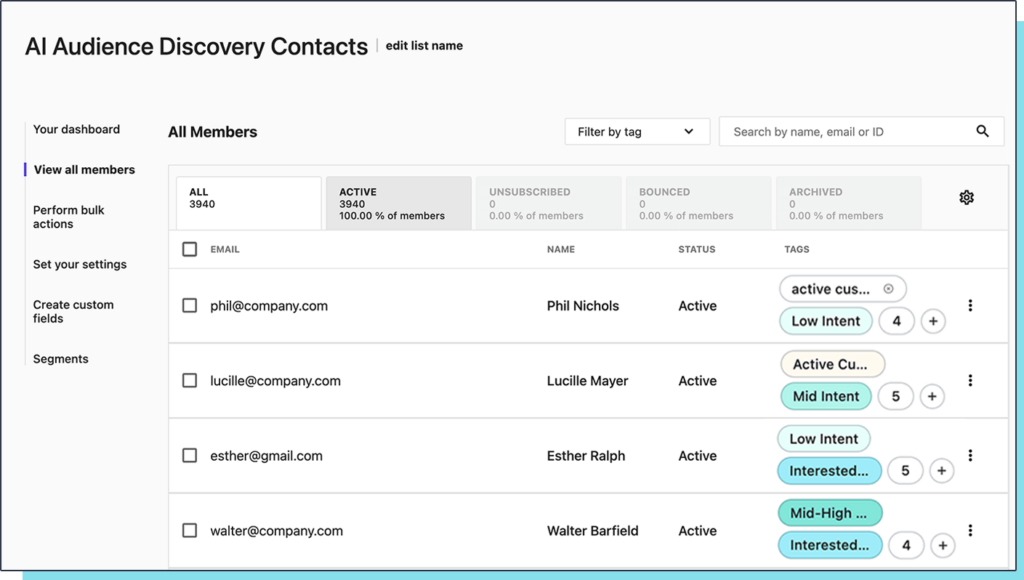
Finally, most software has integrations with other marketing stack, such as CRM solutions, to dive deeper into customer behavior and turn leads into customers.
Run A/B Testing
A/B Testing is a powerful tool in every marketer’s hands that would like to test out several email parts to find what works for their target audience. You can experiment with different subject lines and content to see what your audience finds more interesting before sticking with it.
Keep in mind that not all email services offer complex A/B Testing solutions, so if you want to test more distinct email parts, you may need to resort to more sophisticated tools.
Determine the email frequency
Finally, when building your product recommendation strategy, consider the frequency of those emails combined with the rest of your email messages. Otherwise, subscribers may find your content spammy and report you, which can be damaging for your sender reputation down the line.
So, start out humble, with one or two email campaigns monthly, and when you collect enough data to rely on, you can build more sophisticated flows based on specific triggers. For example, if you deliver back-in-stock emails, you may skip cross-selling campaigns for a while.
Deliver Product Recommendations with Targeted Messaging
Ready to craft your next or even first product recommendation email? Hopefully, our email examples got you inspired and all set to get this strategy moving. Choose the email types your audience will find more appealing and start sending them product recommendations they’d love to see.
Remember, personalization is key, so gather as much data as possible to deliver targeted messages that convert. And if you’re looking for an email marketing service that will automate this process, sign up for a Moosend account today and test out our eCommerce-friendly capabilities.
FAQs
Before we wave you goodbye, here are the answers to the most frequently asked questions around our topic:
1. How do I write a product recommendation email?
Determine the goal of your campaign, add stunning product visuals, and include the benefits of purchasing your recommended products. If possible, add customer reviews or incentives to make them more appealing.
2. Why should I send product recommendation emails?
Product recommendation emails help businesses drive more sales, boost brand awareness, and foster customer engagement through personalization. Plus, they can replace more expensive marketing tactics, such as retargeting ads to cut down on expenses.
3. How can I set up a product recommendation email?
Pick an email marketing service with a relevant feature, choose a premade template, and promote products based on popularity or personalized data such as past purchases.



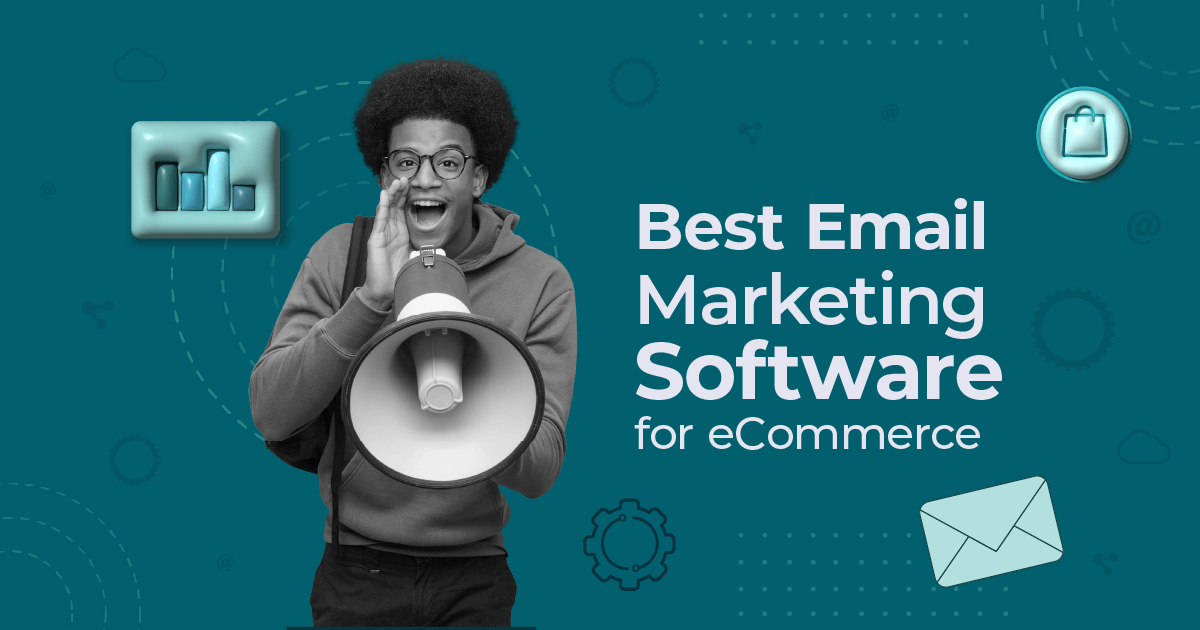
 Published by
Published by

 Published by
Published by
